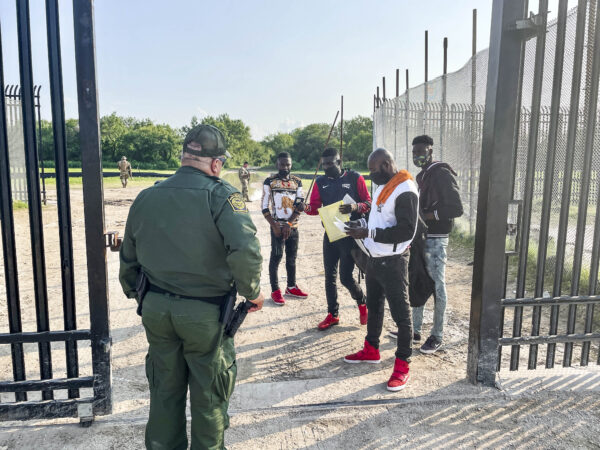Many of the Haitians crossing into the US left Haiti years ago, see now as a good time to come to the US
DEL RIO, Texas—Thousands of Haitians are illegally crossing the southwest border into the United States.
Border Patrol agents have apprehended 15,599 Haitians from January through June this year, according to Customs and Border Protection (CBP) statistics. In the same period last year, 2,097 Haitians were apprehended.
Many of the Haitians left their home country years ago and have been living in South America, according to a Border Patrol agent in the Del Rio Sector, where the vast majority are crossing.
The Epoch Times spoke to several Haitians on July 25, both on the Mexican side of the Rio Grande before they crossed, and on the Del Rio side after they crossed into Texas. That morning, about 350 illegal immigrants were waiting for Border Patrol by the border fence in Del Rio. Most were Haitian.
One Haitian couple said they left Haiti two years ago, and their 9-month-old baby was born in Chile. They plan to live in New York.
One woman said she left Haiti in 2012 and lived in the Dominican Republic. She plans to live in Brooklyn, New York.
Another man left Haiti in October 2016 and flew to Chile. “If you have a family unit, they let you into Chile easily,” he said.
One Haitian man said he left Haiti in September 2019 and went to Brazil first. He’d spent the past four months in Mexico City before crossing the border. He said he has a job lined up in a manufacturing plant in Indianapolis.
Others said they left Haiti four to five years ago.
Just one couple The Epoch Times encountered said they left Haiti recently. Two months ago, they took a boat from Haiti to Chile, then flew to Monterrey, Mexico, before getting on a bus to the border city of Acuña, Mexico, and crossing into Del Rio. They plan to live in Boston.

Identification
Acuña, Mexico, has become a hub for migrants from all over the world to converge and then make illegal entry into the United States. It’s less violent than many of the other cartel-controlled border-crossing plazas in Mexico, and the river is walkable.
A port of entry is nearby, but the migrants say it’s easier for them to cross illegally and harder for the United States to turn them away.
On the riverbank in Acuña, The Epoch Times watched 36 Haitians and Cubans cross within 50 minutes.
Many of the Haitians paused to tear up and discard the paperwork they had with them. Passports, visas, and identification cards were strewn all over the ground. They’re told it’s harder to be deported from the United States if one doesn’t bring ID.
A spokesperson from CBP told The Epoch Times that the agency’s top priority is border security.
“When agents encounter an individual that is not in possession of any form of identification, CBP relies on articulable observations that include agent interviews, interactions between other migrants, and systems records checks to help identify the individual’s nationality,” the spokesperson wrote via email.
“Additionally, CBP may contact the migrant’s stated home country consulate to verify identification.”
The spokesperson didn’t explain what happens to an individual who can’t be identified.
Even with identification, the United States has run into difficulties with deporting Haitians, as the country sometimes refuses to take its citizens back.
Pursuant to a 2001 Supreme Court ruling, Zadvydas v. Davis, Immigration and Customs Enforcement is forced to release illegal immigrants who are in detention and ready for deportation after six months if their country of origin won’t accept them or issue travel documents for them.
In 2015, a Haitian man whom Haiti refused to accept back when the United States tried to deport him was released after six months and subsequently murdered a 25-year-old Connecticut woman in her home.
Waves of Haitians have come into the United States in years past. Historically, border agents have apprehended most Haitians after they crossed into Puerto Rico. And more Haitians have been apprehended at the northern border than at the southern border until in recent years.
From October 2015 through late September 2016 (right before the U.S. presidential election), about 5,000 Haitians presented themselves at California’s San Ysidro port of entry.
Again in 2019, during the last border surge, thousands of Haitians made their way into the United States—not through ports of entry anymore, but into Del Rio after illegally crossing the Rio Grande.

Temporary Protected Status
The Temporary Protected Status (TPS) program is a form of humanitarian relief that has, since 1990, granted temporary legal status and work authorization to nonimmigrant aliens in the United States who are from countries affected by natural disasters, conflict, or other extreme adversity.
About 55,000 Haitians living in the United States are currently beneficiaries of TPS, which allowed Haitian nationals who were in the United States before the devastating 2010 earthquake to stay and work in the United States until it was deemed safe to return.
During the Trump administration, the designation was set to expire and the 55,000 Haitians were expected to return to their home country by July 22, 2019.
At the time, the Department of Homeland Security said the number of displaced people in Haiti had decreased by 97 percent since the 2010 earthquake. A subsequent court ruling placed an injunction on the program’s termination for Haitians, and it continued.
After President Joe Biden took office, Haiti’s TPS designation was extended for 18 months and expanded to include Haitians who had recently entered the United States.
On May 22, Homeland Security Secretary Alejandro Mayorkas said that Haitians who were in the United States as of May 21, 2021, were now eligible to apply for TPS.
The following month, Border Patrol agents apprehended more than 6,000 Haitians, compared to 200 in June 2020.
On July 30, Mayorkas again extended the designation to Haitians who had entered the United States by July 29, in part due to the July 7 assassination of Haiti’s President Jovenel Moïse.
Since the 2010 earthquake, the United States has made available over $5.1 billion in assistance to Haiti, according to the White House.
Citizenship
Some politicians and pro-amnesty advocates have long been trying to create a pathway to citizenship for TPS holders and are eyeing the current budget reconciliation process to achieve it.
However, the Supreme Court ruled on June 7 that TPS isn’t a gateway to a green card. Justice Elena Kagan wrote in the court opinion that entering the country illegally precludes an individual from obtaining a green card.
“‘A grant of TPS does not cure a foreign national’s entry without inspection or constitute an inspection and admission of the foreign national,’” Kagan wrote, quoting a U.S. Citizenship and Immigration Services determination.
Meanwhile, by 2017, about one-quarter of Haitians granted TPS had already either filed for or have been granted lawful permanent resident status.
Nationals from 12 countries currently have TPS designation: El Salvador, Haiti, Honduras, Burma (also known as Myanmar), Nepal, Nicaragua, Somalia, South Sudan, Sudan, Syria, Venezuela, and Yemen.








